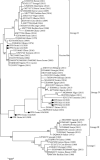Isolation and Molecular Characterization of Peste des Petits Ruminants Virus from Outbreaks in Southern Ethiopia, 2020
- PMID: 35677589
- PMCID: PMC9168182
- DOI: 10.1155/2022/5329898
Isolation and Molecular Characterization of Peste des Petits Ruminants Virus from Outbreaks in Southern Ethiopia, 2020
Abstract
Peste des petits ruminants (PPR) is one of the most important transboundary diseases of small ruminants. In this study, nasal and oral swabs (n = 24) were collected from sheep (n = 7) and goats (n = 17) with clinical signs in southern Ethiopia in March 2020. PPR virus was isolated on Vero dog cells expressing the signaling lymphocyte activation molecule (VDS) and screened using RT-qPCR. Positive samples were confirmed by conventional RT-PCR followed by sequencing of a partial nucleoprotein (N) gene segment. Results revealed that 54% (n = 13/24) of the tested samples were PPRV-positive Phylogenetic analysis revealed that the viruses belonged to lineage IV and lineage II. The lineage IV viruses were similar, although not identical, to other lineage IV viruses previously reported in Ethiopia and other East African countries while the lineage II viruses have been reported for the first time in Ethiopia showed a high nucleotide identity (99.06%) with the vaccine (Nigeria 75/1) that is currently used in Ethiopia for the prevention of PPR. Further investigations are therefore recommended in order to fully understand the true nature of the lineage II PPRVs in Ethiopia.
Copyright © 2022 Abde Aliy Mohammed et al.
Conflict of interest statement
The authors declare no conflicts of interest.
Figures




References
-
- Kabir A., Abro D. H. K. S. H., Kalhoro M. S., et al. Peste des petits ruminants: a review. Pure and Applied Biology . 2019;8(2):1214–1222. doi: 10.19045/bspab.2019.80063. - DOI
-
- Diallo A. Control of peste des petits ruminants: classical and new generation vaccines. Developments in Biologicals . 2003;114:113–119. - PubMed
LinkOut - more resources
Full Text Sources

